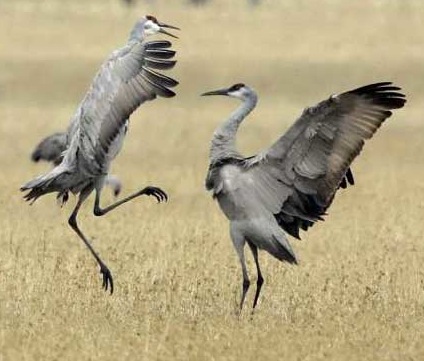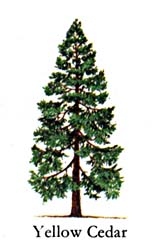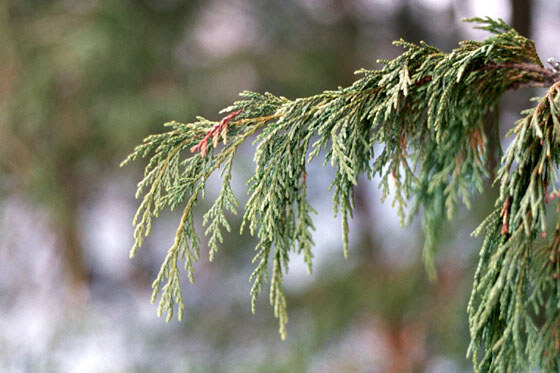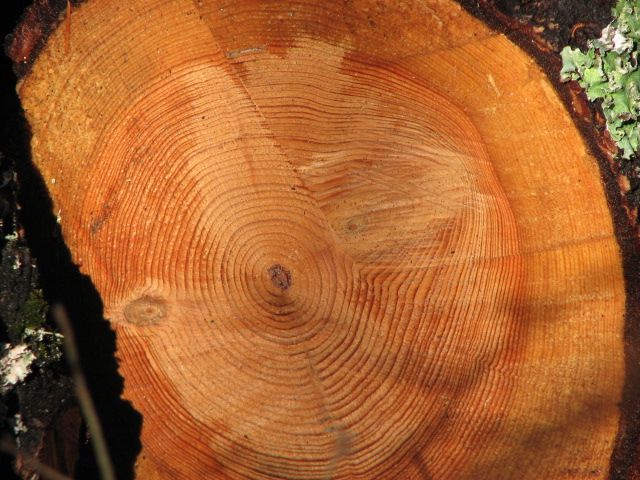
| A crane marsh | ||
|---|---|---|
| A paleontological patent of nobility | ||
 |
||
| "Our ability to perceive quality in nature begins, as in art, with the pretty. It expands, through successive stages of the beautiful to values as yet uncaptured by language. The quality of cranes lies, I think, in this higher gamut, as yet beyond the reach of words.... | ||
| Aldo Leopold, 1949 | ||
Two sandhill cranes–a species known for its balletic "dance moves" and tendency to make elaborate vocalizations– perform a dance of sorts in Gibbon, Neb., in 2006. Sandhill cranes stop in the area every year during their migration. Los Angeles Times. |
||
| Non-economic values | ||
Our appreciation of the crane grows with the slow unraveling of earthly history. His tribe, we now know, stems out of the remote Eocene. The other members of the fauna in which he originated are long since entombed within the hills. When we hear his call we hear no mere bird. We hear the trumpet in the orchestra of evolution....
And so they live and have their being –these cranes– not in the constricted present but in the wider reaches of evolutionary time. Their annual return is the ticking of the geologic clock. Upon the place of their return they confer a peculiar distinction. Amid the endless mediocrity of the commonplace, a crane marsh holds a paleontological patent of nobility, won in the march of aeons...."
* * Aldo Leopold, SAND COUNTY ALMANAC, 1949
Tall trees of great age.
Found only on the Pacific coast of North America,  Yellow Cedar is the hardest known cedar in the world. Only a limited amount of this wood is available every year.
Yellow Cedar is the hardest known cedar in the world. Only a limited amount of this wood is available every year.
Chamaecyparis nootkatensis (Yellow-cedar tree)
PORTLAND, Oregon. February 1, 2012.
Yellow-cedar, a culturally and economically valuable tree in southeastern Alaska and adjacent parts of British Columbia, has been dying off across large expanses of these areas for the past 100 years. But no one could say why—until now.
“The cause of tree death, called yellow-cedar decline, is now known to be a form of root freezing that occurs during cold weather in late winter and early spring, but only when snow is not present on the ground,” explains Pacific Northwest Research Station scientist Paul Hennon, co-lead of a synthesis paper recently published in the February issue of the journal BioScience. “When present, snow protects the fine, shallow roots from extreme soil temperatures. The shallow rooting of yellow-cedar, early spring growth, and its unique vulnerability to freezing injury also contribute to this problem.”
 Yellow-cedar decline affects about 60 to 70 percent of trees in forests covering 600,000 acres in Alaska and British Columbia. The paper, “Shifting Climate, Altered Niche, and a Dynamic Conservation Strategy for Yellow-Cedar in the North Pacific Coastal Rainforest,” summarizes 30 years of research and offers a framework for a conservation strategy for yellow-cedar in Alaska.
Yellow-cedar decline affects about 60 to 70 percent of trees in forests covering 600,000 acres in Alaska and British Columbia. The paper, “Shifting Climate, Altered Niche, and a Dynamic Conservation Strategy for Yellow-Cedar in the North Pacific Coastal Rainforest,” summarizes 30 years of research and offers a framework for a conservation strategy for yellow-cedar in Alaska.
Some key findings include:
• The complex cause of yellow-cedar decline is related to reduced snow, site and stand characteristics, shallow rooting, and the unique vulnerability of the roots to freezing in low temperatures.
• Low snow levels and poor soil drainage lead to impact root injury and the eventual death of yellow-cedar trees. The tree thrives in wet soils, but its tendency to produce shallow roots to access nitrogen on these sites made it more vulnerable when spring snow levels were reduced by climate warming.
• Yellow-cedar health depends on changing snow patterns, thus locations for appropriate conservation and management activities need to follow the shifting snow patterns on the landscape.
• Some responses to shifting climate are expected to be complex and difficult to anticipate. Long-term multidisciplinary research was needed to determine the true role of climate in the health of yellow-cedar and untangle it from other processes and natural cycles in forests.
The yellow-cedar is a slow-growing tree; many are 700 to 1,200 years old. The tree has long been culturally significant to Native Alaskans who use it to make paddles, masks, dishes, and woven items. The wood is also very valuable commercially (for home and boat building) because of its straight grain, durability, and resistance to insects.

The number of tree rings reveal the age of a tree, but also the growth conditions form one year to another.
economy of fools vs. demand growth
What will abrupt changes mean?
Bill McKibben | Williams on pan | Emerson | Wild leisure | Margulis | index to Leopold | Symbiosis | Wildlife refuges